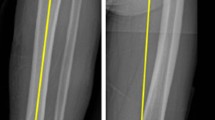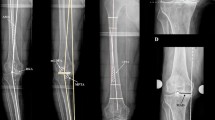Abstract
Purpose
Some recent articles have suggested that in the case of large varus deformity, it may be advantageous to leave some residual post-operative varus as a means of improving functional outcome.
The objective of this study is to compare the results of total knee replacement (TKR) performed for significant varus deformity (HKA < 170°) where there is a residual post-operative varus (HKA < 180°) to the results of TKR for significant varus deformity with either neutral post-operative (HKA = 180°) or mild valgus post-operative alignment (HKA > 180°).
Methods
This series was made up of 208 knees. The mean pre-operative HKA angle was 166 ± 3° (154–169°), of which 150 were followed up for a mean 8.5 years (58 lost to follow-up). Based on post-operative radiographs, two groups were formed: group 1 (88 knees) in which post-operative alignment was 177.8 ± 1° (175–179°) and group 2 (62 knees) in which post-operative alignment was 181 ± 1° (180–184°).
Results
The mean international knee society (IKS) score for group 1 was 178.8 ± 22 points (113–200) and 181.7 ± 22 points (95–200) for group 2. Oxford knee score was 20.4 ± 9 points (12–45) in group 1 and 19.2 ± 9 (12–50) in group 2. The results were slightly better in group 2 (in slight valgus) but this difference was not statistically significant (p = 0.44 and 0.4).
Conclusion
The results of knee replacement performed for severe varus deformity are not adversely affected by post-operative valgus alignment. There is in fact a trend towards superior results for neutral or valgus alignment than slight residual varus, but this difference was not statistically significant.


Similar content being viewed by others
References
Insall JN, Hood RW, Flawn LB, Sullivan DJ (1983) The total condylar knee prosthesis in gonarthrosis. A five to nine-year follow-up of the first one hundred consecutive replacements. J Bone Joint Surg Am 65:619–628
Ritter MA, Davis KE, Meding JB et al (2011) The effect of alignment and BMI on failure of total knee replacement. J Bone Joint Surg Am 93:1588–1596. https://doi.org/10.2106/JBJS.J.00772
Sikorski JM (2008) Alignment in total knee replacement. J Bone Joint Surg Br 90:1121–1127. https://doi.org/10.1302/0301-620X.90B9.20793
Sharkey PF, Hozack WJ, Rothman RH et al (2002) Insall award paper. Why are total knee arthroplasties failing today? Clin Orthop Relat Res 404:7–13
Ritter MA, Faris PM, Keating EM, Meding JB (1994) Postoperative alignment of total knee replacement. Its effect on survival. Clin Orthop Relat Res 299:153–156
Parratte S, Pagnano MW, Trousdale RT, Berry DJ (2010) Effect of postoperative mechanical axis alignment on the fifteen-year survival of modern, cemented total knee replacements. J Bone Joint Surg Am 92:2143–2149. https://doi.org/10.2106/JBJS.I.01398
Bellemans J, Colyn W, Vandenneucker H, Victor J (2012) The Chitranjan Ranawat award: is neutral mechanical alignment normal for all patients? The concept of constitutional varus. Clin Orthop Relat Res 470:45–53. https://doi.org/10.1007/s11999-011-1936-5
Vanlommel L, Vanlommel J, Claes S, Bellemans J (2013) Slight undercorrection following total knee arthroplasty results in superior clinical outcomes in varus knees. Knee Surg Sports Traumatol Arthrosc 21:2325–2330. https://doi.org/10.1007/s00167-013-2481-4
Howell SM, Howell SJ, Kuznik KT et al (2013) Does a kinematically aligned total knee arthroplasty restore function without failure regardless of alignment category? Clin Orthop Relat Res 471:1000–1007. https://doi.org/10.1007/s11999-012-2613-z
Ramadier JO, Buard JE, Lortat-Jacob A, Benoit J (1982) Radiological assessment of knee deformity in the frontal plane (author’s transl). Rev Chir Orthop Reparatrice Appar Mot 68:75–78 French
Maderbacher G, Baier C, Benditz A, Wagner F, Greimel F, Grifka J, Keshmiri A (2017) Knee arthroplasty and impact on measured lower limb and component alignment. Int Orthop 41:1553–1560. https://doi.org/10.1007/s00264-017-3408-3
Insall JN, Dorr LD, Scott RD, Scott WN (1989) Rationale of the knee society clinical rating system. Clin Orthop Relat Res 248:13–14
Dawson J, Fitzpatrick R, Murray D, Carr A (1998) Questionnaire on the perceptions of patients about total knee replacement. J Bone Joint Surg Br 80:63–69
Ewald FC (1989) The knee society total knee arthroplasty roentgenographic evaluation and scoring system. Clin Orthop Relat Res 248:9–12
Saragaglia D, Roberts J (2005) Navigated osteotomies around the knee in 170 patients with osteoarthritis secondary to genu varum. Orthopedics 28(Suppl 10):S1269–S1274
Kamat YD, Aurakzai KM, Adhikari AR et al (2009) Does computer navigation in total knee arthroplasty improve patient outcome at midterm follow-up? Int Orthop 33:1567–1570. https://doi.org/10.1007/s00264-008-0690-0
Longstaff LM, Sloan K, Stamp N et al (2009) Good alignment after total knee arthroplasty leads to faster rehabilitation and better function. J Arthroplast 24:570–578. https://doi.org/10.1016/j.arth.2008.03.002
Puliero B, Favreau H, Eichler D, Adam P, Bonnomet F, Ehlinger M (2018) Total knee arthroplasty in patients with varus deformities greater than ten degrees: survival analysis at a mean ten year follow-up. Int Orthop. https://doi.org/10.1007/s00264-018-4019-3
Matziolis G, Adam J, Perka C (2010) Varus malalignment has no influence on clinical outcome in midterm follow-up after total knee replacement. Arch Orthop Trauma Surg 130:1487–1491. https://doi.org/10.1007/s00402-010-1064-9
Magnussen RA, Weppe F, Demey G et al (2011) Residual varus alignment does not compromise results of TKAs in patients with preoperative varus. Clin Orthop Relat Res 469:3443–3450. https://doi.org/10.1007/s11999-011-1988-6
D’Lima DD, Chen PC, Colwell CW (2001) Polyethylene contact stresses, articular congruity, and knee alignment. Clin Orthop Relat Res 392:232–238
Morin V, Pailhé R, Rubens-Duval B, Mader R, Cognault J, Rouchy RC, Saragaglia D (2017) Gait analysis following medial opening-wedge high tibial osteotomy. Knee Surg Sports Traumatol Arthrosc. https://doi.org/10.1007/s00167-017-4421-1
Saragaglia D, Rouchy RC, Krayan A, Refaie R (2014) Return to sports after valgus osteotomy of the knee joint in patients with medial unicompartmental osteoarthritis. Int Orthop 38:2109–2114. https://doi.org/10.1007/s00264-014-2435-6
Delport H, Labey L, Innocenti B et al (2015) Restoration of constitutional alignment in TKA leads to more physiological strains in the collateral ligaments. Knee Surg Sports Traumatol Arthrosc 23:2159–2169. https://doi.org/10.1007/s00167-014-2971-z
Slevin O, Amsler F, Hirschmann MT (2016) No correlation between coronal alignment of total knee arthroplasty and clinical outcomes: a prospective clinical study using 3D-CT. Knee Surg Sports Traumatol Arthrosc 25:3892–3900. https://doi.org/10.1007/s00167-016-4400-y
Fang DM, Ritter MA, Davis KE (2009) Coronal alignment in total knee arthroplasty: just how important is it? J Arthroplast 24:39–43. https://doi.org/10.1016/j.arth.2009.04.034
Huang TW, Lee CY, Lin SJ, Lee MS, Hsu RW, Shen WJ (2015) The influence of alignment on midterm outcome after total knee arthroplasty in patients with marked coronal femoral bowing. J Arthroplast 30:1531–1536. https://doi.org/10.1016/j.arth.2015.03.027
Collier MB, Engh CA, McAuley JP, Engh GA (2007) Factors associated with the loss of thickness of polyethylene tibial bearings after knee arthroplasty. J Bone Joint Surg Am 89:1306–1314. https://doi.org/10.2106/JBJS.F.00667
Saragaglia D, Sigwalt L, Gaillot J et al (2017) Results with eight and a half years average follow-up on two hundred and eight e-motion FP® knee prostheses, fitted using computer navigation for knee osteoarthritis in patients with over ten degrees genu varum. Int Orthop. https://doi.org/10.1007/s00264-017-3618-8
Vandekerckhove PJ, Lanting B, Bellemans J et al (2016) The current role of coronal plane alignment in total knee arthroplasty in a preoperative varus aligned population: an evidence-based review. Acta Orthop Belg 82:129–142
Hollister AM, Jatana S, Singh AK et al (1993) The axes of rotation of the knee. Clin Orthop Relat Res 298:259–268
Howell SM, Papadopoulos S, Kuznik K et al (2015) Does varus alignment adversely affect implant survival and function six years after kinematically aligned total knee arthroplasty? Int Orthop 39:2117–2124. https://doi.org/10.1007/s00264-015-2743-5
Dossett HG, Swartz GJ, Estrada NA et al (2012) Kinematically versus mechanically aligned total knee arthroplasty. Orthopedics 35:e160–e169. https://doi.org/10.3928/01477447-20120123-04
Ishikawa M, Kuriyama S, Ito H et al (2015) Kinematic alignment produces near-normal knee motion but increases contact stress after total knee arthroplasty: a case study on a single implant design. Knee 22:206–212. https://doi.org/10.1016/j.knee.2015.02.019
Author information
Authors and Affiliations
Corresponding author
Ethics declarations
Conflict of interest
The authors declare that they have no conflict of interest related to this article. D. Saragaglia receives royalties from B-Braun related to the e-Motion Knee Prosthesis. The other authors had, sometimes, financial support for attending orthopaedics meetings.
Ethical approval
This article does not contain any studies with human participants or animals performed by any of the authors.
Informed consent
Informed consent was obtained from all individual participants included in the study.
Rights and permissions
About this article
Cite this article
Saragaglia, D., Sigwalt, L., Refaie, R. et al. Influence of the post-operative axis on the clinical results of total knee replacement for severe varus deformities: does a slight residual varus improve the results?. International Orthopaedics (SICOT) 43, 1621–1626 (2019). https://doi.org/10.1007/s00264-018-4092-7
Received:
Accepted:
Published:
Issue Date:
DOI: https://doi.org/10.1007/s00264-018-4092-7




